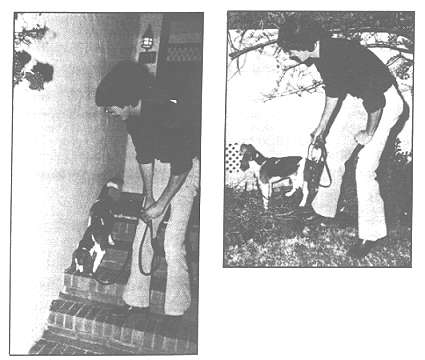 Hermie stole the show from a distinguished list of speakers at the August annual clinic sponsored by the New Jersey Pest
Control Association. And he did so without saying a word.
Hermie stole the show from a distinguished list of speakers at the August annual clinic sponsored by the New Jersey Pest
Control Association. And he did so without saying a word.
Hermie is a termite-sniffing beagle, trained by Robert Outman, president of the Prion Animal Institute in San Carlos,
California. Along with other beagles, Hermie has the capability to extend the effectiveness with which a termite inspector
can identify infestations of subterranean, dry wood, and dampwood termites.
Outman gave Pest Control an exclusive interview during his visit to the Rutgers University location of the NJPCA
clinic and then addressed the members on the development and use of these unique dogs. At a clambake following the clinic,
he gave a demonstration of Hermie's skills.
Outman was happy to respond to the NJPCA invitation to talk about his termite-inspection dogs because, while currently used
exclusively in California, he plans to provide them on a nationwide basis. "Wherever we can get twenty commitments for the
dogs, we will set up a field office," said Outman.
Outman's Institute is the largest, most extensive commercial animal training institute in the Western States. He has more
than 14 year's experience in handling and training police patrol dogs and family dogs. Many of the dogs he has trained have
been recognized formally as champion police dogs and explosive detecting canines. His dogs are also trained to locate narcotics,
so it was natural that Outman, when he encountered a termite infestation in a new home he had bought, would think in terms
of developing dogs to be used as instruments for termite inspection.
This occurred when Outman discovered that, despite the fact that his new home had been previously inspected, nearly half of it
was inaccessible to inspectors and thus there was no easy way to know the full extent of infestation.
As Outman discovered, inspectors must be able to see either active infestation or evidence of it to certify the presence
of termites. After studying the problem, using statistics furnished by the State Structural Pest Control Board in Sacramento
for the years of January 1966 through June 1978, Outman determined that, in seven major counties, an average of 45.6% of the
space within a home was deemed "inaccessible" to inspectors. In San Francisco, some 30 miles north of San Carlos, the average
rises to nearly 70% of a home.
Outman knew that beagles rank in the 99th percentile of olfactory sensitivity. Moreover, the size of the dog enhances its
ability to get into areas that a man cannot. Then there was the human aspect. "An inspector can take a beagle in a house and
it's not going to scare anybody. Even people who don't like dogs gravitate to beagles." Certainly, everyone who met Hermie
during his visit to the clinic fell instantly in love with this charming one-year old bundle of enrgy and fun.
The training Hermie received, starting as all termite-sniffing beagles do, at five weeks of age, makes him a very social dog,
unconcerned about being around people and totally out-going.
Are Dogs A Serious Answer?
While Hermie proved a great hit and has even been featured on nationwide television for his unique abilities, the question
remains whether dogs are a serious answer to the problem of identifying infestations. In 1977, Outman noted, nearly a million
structural inspections for termite infestation were conducted throughout the State of California. Multiply this against the
possible total nationwide at this time and one can clearly see that a need exists and, in particular, a means that goes beyond
the traditional tools of the inspector, a flashlight and screw driver.
Outman maintains that the use of the specially-trained dogs will increase the accessibility of the homes to be inspected by 50% as
well as increase the reliability of the inspection and the client's confidence in the work performed.
The training and certification of the dogs in intensive. In a slide presentation to the audience attending the all-day clinic,
Outman showed how the dogs are trained to go virtually anywhere from the roof to the enclosed areas in a home.
Not only is the dog trained, the handlers must go through a lengthy training themselves to learn all facets of dog psychology,
health care, record keeping, and recognition of the body movements the detection dog makes when it finds an infestation (the
dogs are trained to scratch at the specific area). The certification process for both the dog and handler involves at least
twenty-five (25) "blind" finds with 100% accuracy. Both are rated by trainers and, every thirty days, a re-certification process
is conducted with a field inspection to calibrate the dog's ability to discriminate the presence of termites and the handler's
skill with the dog.
Outman has found a certain initial resistance to the new concept. "One of the things that's a problem is getting inspectors to
realize that the dogs are of value to them," said Outman, but this may just be accountable for the newness of the idea.
Certainly, clients which have benefited from the detection of termite infestations are completely convinced. A San Mateo banker
wrote to say, "I believe this experiment to be proof positive that your dogs have great credibility," after they found an
infestation in his home, one with "absolutely no visible signs..." Rich Castelli of Bay Pest Termite Control Company, San Mateo,
relates, "I have been assisted on many inspections by my dog. He has made possible the discovery of active termite infestations in varying
circumstances... (and) greatly increases my effectiveness as a termite inspector."
If you wish to receive more information, you can write to the Prion Institute, 851 Old Country Road, San Carlos, California
94070 and ask about "TAD Services Company" (Termite and Dry Rot Detection).
|